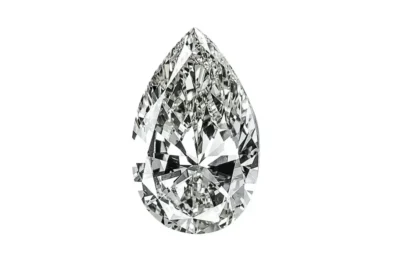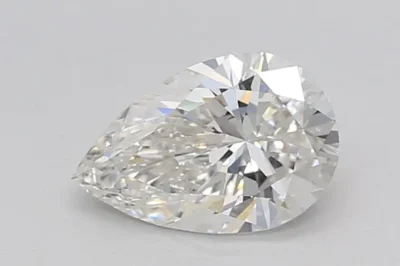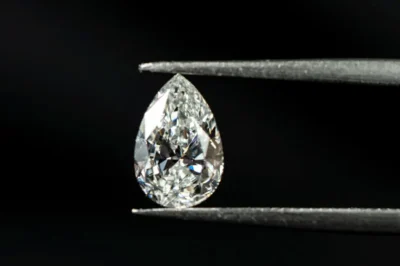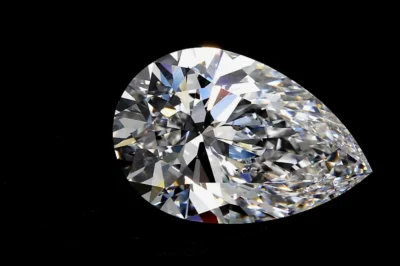When it comes to diamonds, the pear-shaped cut stands out as a unique and elegant option. Combining the timeless appeal of the round brilliant with the elongated style of the marquise, pear-shaped diamonds—or teardrop diamonds—offer a distinct blend of brilliance, elegance, and versatility.
In recent years, pear-shaped lab diamonds have surged in popularity. Lab-grown diamonds allow buyers to enjoy this stunning shape at a fraction of the price of natural diamonds, all while supporting ethical and sustainable sourcing.
If you’re considering a pear-shaped lab diamond for an engagement ring or fine jewelry, this guide will walk you through everything you need to know—from cut quality and the 4Cs to setting styles and budgeting tips. By the end, you’ll have the confidence to make an informed purchase that perfectly fits your style, preferences, and values.
What Is a Pear-Shaped Lab Diamond?
Understanding the Pear Cut
The pear-shaped diamond is also known as the teardrop cut. Its design combines the rounded brilliance of a traditional round diamond with the elegant taper of a marquise. This shape elongates the finger and creates a striking visual impact, whether set in a solitaire engagement ring, halo setting, or pendant.
Lab-Grown vs. Natural Pear-Shaped Diamonds
Lab-grown diamonds are chemically, physically, and optically identical to natural diamonds. The main differences are their origin, price, and ethical footprint. Choosing a pear-shaped lab diamond offers the same brilliance and fire as natural stones but at a lower cost and without the environmental and ethical concerns associated with mining.
Why Pear-Shaped Lab Diamonds Are Trending
The combination of affordability, ethical sourcing, and unique aesthetics makes pear-shaped lab diamonds increasingly popular among modern buyers. Their elongated silhouette is flattering on all finger types, and the rarity of the pear shape ensures your jewelry stands out from the crowd.
Why Choose Pear-Shaped Lab Diamonds?
Elegant and Finger-Flattering
The pointed end of a pear-shaped diamond naturally elongates the finger, creating a slimming effect. This makes it a popular choice for engagement rings, cocktail rings, and statement jewelry pieces.
Sparkle and Brilliance
Thanks to its hybrid cut, a pear-shaped diamond can reflect light as brilliantly as a round cut while offering a unique silhouette. The mix of curved and pointed edges creates captivating sparkle, giving pear-shaped diamonds their signature fire.
Unique but Timeless
Pear-shaped diamonds are not as common as round or princess cuts, making them a standout choice for buyers seeking something distinctive. At the same time, their elegant teardrop shape maintains a timeless appeal, ensuring the piece remains stylish for decades.
Cost and Ethical Benefits
Lab-grown diamonds are typically 30–40% less expensive than natural diamonds. Choosing a pear-shaped lab diamond means you can purchase a larger or higher-quality stone while supporting sustainable, conflict-free practices.
The Anatomy of a Pear-Shaped Diamond
Understanding the structure of a pear-shaped diamond is essential for evaluating quality.
Head, Point, and Belly
- Head (rounded end): This end reflects light most brilliantly.
- Point (tapered end): The narrow end adds elegance but is more vulnerable to chipping.
- Belly (widest section): The middle portion gives the diamond its overall body and volume.
Symmetry and Balance
Perfect symmetry is critical for a pear-shaped diamond. A well-cut pear should have evenly matched shoulders, a properly centered tip, and balanced proportions. Poor symmetry can make the diamond appear lopsided or uneven.
Bow-Tie Effect
Many pear-shaped diamonds exhibit a “bow-tie” effect—a dark shadow resembling a bow tie across the center. While some bow-tie is natural, a well-cut pear-shaped diamond minimizes this effect, maintaining maximum brilliance and fire.
The 4Cs of Pear-Shaped Lab Diamonds
1. Cut Quality
The cut of a pear-shaped diamond affects brilliance, sparkle, and overall beauty.
- Length-to-Width Ratio: Ideal ratios range from 1.45:1 to 1.75:1, depending on your preference for a slim or wider appearance.
- Symmetry: Balanced shoulders and a centered point prevent a lopsided look.
- Minimizing Bow-Tie Effect: Look for stones that reflect light evenly, reducing shadowed areas.
2. Color Grading
Color shows differently in pear-shaped diamonds than in round cuts.
- Best Grades: For lab-grown pear diamonds, G-H color offers a near-colorless appearance that complements most settings.
- Personal Preference: Some buyers prefer warmer tones (I-J) for a romantic glow, while others prefer icy whites (D-F) for maximum brilliance.
3. Clarity Considerations
Inclusions are most noticeable near the pointed tip of pear-shaped diamonds.
- Recommended Grades: VS1-VS2 clarity provides a clean look without visible inclusions.
- Inclusions Location: Check for inclusions that could weaken the point or appear in highly visible areas.
4. Carat Weight
Pear-shaped diamonds appear larger than their carat weight suggests due to their elongated shape.
- Popular Carat Ranges: 0.75–2.0 carats for engagement rings.
- Price Considerations: Lab-grown diamonds allow you to choose higher carat weights without exceeding your budget.
Choosing the Perfect Pear-Shaped Lab Diamond
Matching Diamond Size to Hand Shape
- Slim Fingers: Slightly wider pears create balance.
- Short Fingers: Longer, narrower pears elongate the appearance.
Finding the Right Ratio
- Slim vs. Balanced vs. Wide: Personal style dictates preference.
- A slim pear elongates fingers, while a slightly wider pear maximizes perceived size.
Brilliance vs. Elegance
Some buyers prioritize sparkle, while others focus on shape elegance. Choose a pear-shaped lab diamond that balances both according to your taste.
Best Settings for Pear-Shaped Lab Diamonds
Solitaire Setting
- Classic and timeless.
- Puts the focus entirely on the diamond.
Halo Setting
- Surrounds the pear with smaller diamonds, enhancing sparkle.
- Offers additional protection for the pointed tip.
Bezel Setting
- Modern and sleek.
- Protects the tip from chipping while maintaining brilliance.
Three-Stone Setting
- Symbolic of past, present, and future.
- Adds visual interest and enhances size appearance.
Engagement Ring Styles Featuring Pear-Shaped Lab Diamonds
Vintage-Inspired Pear Rings
- Intricate detailing and filigree work.
- Combines antique elegance with the modern appeal of lab-grown diamonds.
Minimalist Solitaire Pear Rings
- Focuses on clean lines and simplicity.
- Ideal for buyers who love understated elegance.
Side-Stone Pear Designs
- Flanked by smaller diamonds for added brilliance.
- Highlights the unique shape while increasing overall sparkle.
Double Pear Rings
- Two pear-shaped diamonds facing opposite directions.
- Trendy and eye-catching, perfect for fashion-forward buyers.
Pros and Cons of Pear-Shaped Lab Diamonds
Pros
- Distinctive, eye-catching cut.
- Elongates fingers elegantly.
- Affordable and ethical compared to natural diamonds.
Cons
- Prone to chipping at the point.
- Symmetry is critical; poorly cut stones look uneven.
- Bow-tie effect can affect appearance if not minimized.
Care and Maintenance Tips for Pear-Shaped Diamonds
Protecting the Pointed Tip
- Avoid impacts or knocks that could damage the tip.
- Consider prong or bezel settings for added protection.
Cleaning and Storage
- Regular professional cleaning preserves brilliance.
- Store separately to prevent scratching other jewelry pieces.
Pear-Shaped Lab Diamonds vs. Other Popular Cuts
Pear vs. Oval Lab Diamonds
- Pear: Pointed elegance, unique.
- Oval: Uniform brilliance, classic but less distinctive.
Pear vs. Round Lab Diamonds
- Pear: Elongating effect, eye-catching.
- Round: Maximum sparkle, traditional.
Pear vs. Marquise Lab Diamonds
- Pear: Rounded end softens the look.
- Marquise: Aggressive points, more dramatic style.
Where to Buy Pear-Shaped Lab Diamonds
Choosing a Trustworthy Retailer
- Certification and grading reports are essential.
- Reputation and customer reviews matter.
Custom-Made Pear Rings
- Customization allows you to select the perfect size, ratio, and setting.
- Many jewelers offer lab-grown options for bespoke designs.
Budgeting and Pricing for Pear-Shaped Lab Diamonds
Understanding Costs
- Lab diamonds are 30–40% more affordable than natural diamonds.
- Larger carats, higher clarity, and premium cut quality affect pricing.
Smart Budgeting Tips
- Prioritize cut and shape over carat weight for appearance.
- Compare multiple lab-grown options before committing.

Styling Tips: Wearing Pear-Shaped Diamond Jewelry
Engagement Rings and Wedding Bands
- Matching bands can enhance elegance.
- Consider tapered or contoured bands for a seamless look.
Fashion Jewelry
- Pear pendants, earrings, and cocktail rings make bold statements.
- Ideal for layering with complementary jewelry.
Celebrity Inspiration
- Many celebrities choose pear-shaped diamonds for their distinctive appeal and red-carpet glamour.
- Use popular styles as inspiration for your own jewelry.
Final Buying Checklist for Pear-Shaped Lab Diamonds
- Confirm certification and grading.
- Inspect symmetry, polish, and bow-tie effect.
- Ensure the setting protects the pointed tip.
- Balance budget, quality, and style.
Conclusion
Pear-shaped lab diamonds are a stunning and practical choice for modern buyers. They offer a perfect blend of elegance, brilliance, and affordability while supporting ethical and sustainable sourcing. With proper attention to cut, clarity, color, and setting, a pear-shaped lab diamond can be a timeless investment that captures attention and admiration for years to come.
Whether you’re designing a custom engagement ring, choosing a statement fashion piece, or gifting a loved one, pear-shaped lab diamonds offer unmatched versatility, style, and sparkle. Start exploring today and find the perfect teardrop gem that reflects your personality, values, and taste.






